Since I’ve had the new milk goats, I’ve been making a lot of goat’s milk soap. To make a goat’s milk soap that’s not dark, I focused on cold process methods. There’s nothing wrong with a darker soap, it’s just an aesthetic issue. Milk soaps are darker than soaps made from a water base because of the reaction of the lye to the sugars in milk. When mixing milk and lye, the milk will turn an orange color. (Basically, the milk is scalded by the chemical reaction with the lye.) Later, this color translates to a dark brown in the finished soap–especially if it’s a cooked soap made by hot process. I had a lot of success with the cold process goat’s milk soap method I outlined here. The soap depicted in that post was made with coffee grounds, for a coffee scrub soap, and even the addition of coffee grounds didn’t darken the soap. Three weeks later, it’s still a nice, light cold process soap that saponified within two weeks (despite being refrigerated immediately after being placed in the mold). That quick cool-down in the fridge aided in keeping a loaf mold soap from continuing to heat the milk, though it did slow final saponification.
Could it be done in hot process? Am I not the person who said to forget about making a lighter goat’s milk soap with the hot process method? Sometimes I eat my words, and I’m happy to eat them! I’ve done numerous test methods with goat’s milk soap and the hot process method, despite being perfectly happy with the cold process method I outlined in the afore-linked coffee scrub post. That method was a 50% goat’s milk and 50% water method. That’s still a good percentage of goat’s milk in the soap, but. What about a 100% goat’s milk soap? And what about hot process? I teach the hot process method of soapmaking in workshops. And the reason for that is because of the immediate gratification factor. During one-day workshops, I’m dealing with limited time constraints. I need to send fully-saponified soap home with attendees within hours of them making the soap. This means hot process. And there are plenty of other reasons to make soap by the hot process method anyway. I’ve always been a hot process fan. To me, it’s just a more authentic method. I’m a sucker for the old-fashioned way. And I love soap that’s soap right away. But how to make a perfect hot process goat’s milk soap, that doesn’t get that bad cooked-milk stink, doesn’t turn horribly dark, cooks/saponifies quickly, and is actually a full 100% goat’s milk soap?
Test after test after test after test later…. The method I developed from trial and error is what I call hot process goat’s milk soap with a cold process treatment, because the brainstorms and light bulbs that went off in my head that led to this incredible result came from my experiments in cold process–which I then applied to my thinking about hot process.
Why do I call it incredible?
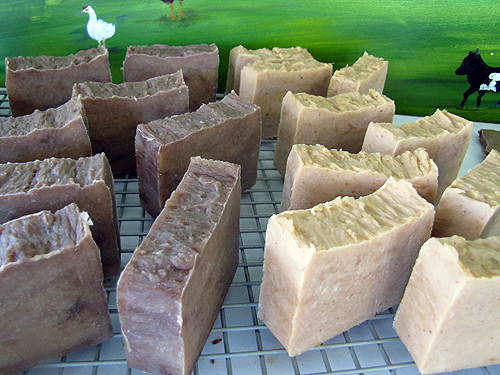
The soap on the left is a hot process goat’s milk soap made the usual hot process way, and there’s even only 4 ounces of goat milk in the soap. The soap on the right is the hot process goat’s milk soap made with the cold process treatment–and it’s made with 100% goat’s milk. You tell me if that’s not an incredible difference. NO WAY can a hot process goat’s milk soap with 12 ounces of goat’s milk be that much lighter than a hot process soap made with just 4 ounces of goat’s milk.
Yes way. It’s all in the method. I’m gonna show you how. If you’re ready to get down to the business end of your stick blender, let’s go!
 Printer-Friendly
Printer-Friendly
Crisco — 9.6 ounces or 272.155 grams
olive oil OR olive oil pomace — 9.6 ounces or 272.155 grams
lard — 6.4 ounces or 181.437 grams
coconut oil (76-degree melt point) — 6.4 ounces or 181.437 grams
goat’s milk — 12.16 ounces or 344.73 grams
lye — 4.463 ounces or 126.524 grams
CAUTION: Always be safe. Wear goggles and gloves any time you’re dealing with lye and while handling the soap until it tests non-caustic.
How to make Perfect Hot Process Goat’s Milk Soap:
Gather all tools, utensils, ingredients, and other supplies including your molds and prepare your work area.
Step 1
Weigh your goat’s milk and place in the freezer. Wait about an hour, with the milk chilling in the freezer, then move on to Step 2.
Step 2
Weigh each fat/oil. Place fats/oils in a crock pot on Low. Heat until completely melted. Turn the crock pot off. Remove crock from pot and place on a wire rack to cool.

It’s not necessary to take the temperature of the mixture–just let it cool while you move on to Step 3.
Step 3
Put on your goggles and gloves. Weigh the lye. Remove the milk from the freezer–it should be very cold by now, like a slushy. It doesn’t need to be completely frozen. Begin to gradually add the lye to the milk. DO NOT add very much at a time. ALWAYS ADD LYE TO THE MILK, not the other way around. Adding the lye to the milk should take about 45 minutes. This keeps the entire mixture at a controlled cool temperature during the combining of the milk and lye, and is a key part of the “cold process treatment” you’re giving to the hot process soap.
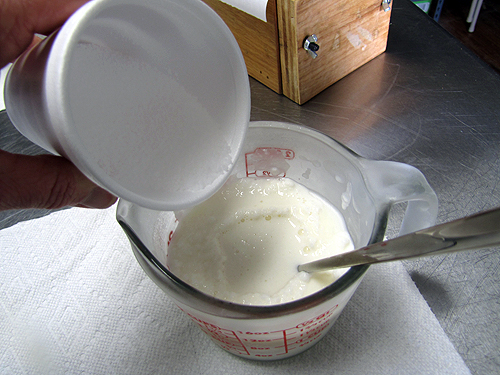
Over the course of the slow lye addition to the milk, the mixture will turn yellowish.
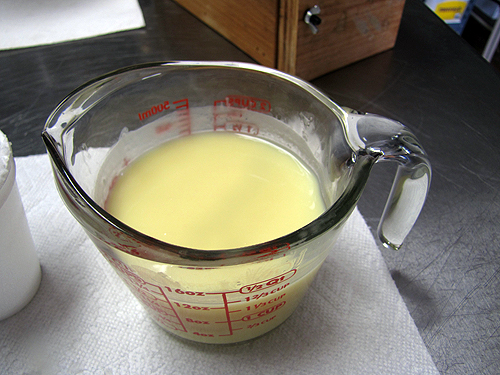
By the time you’re finished, it will be a lemon-y color. With your crock back in the pot (heat still off), it’s time to combine the lye/milk mixture with the melted and cooled fats/oils.
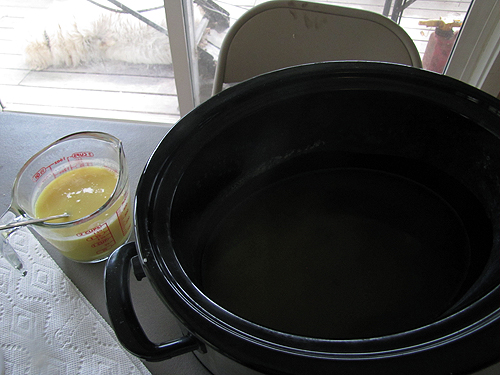
Step 4
Carefully pour the lye/milk mixture into the fats/oils and begin stick blending.
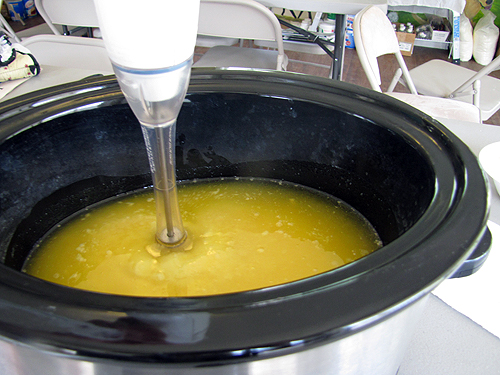
Once you reach a nice, strong trace, it’s time to turn the crock pot back on Low.

Step 5
Put on the lid, but check back frequently. Early in the cook:
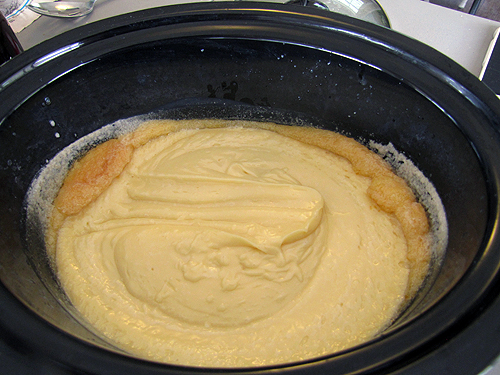
Mid-cook:

As the mixture turns from the outside in into a gel state, the extra and variable fat in goat’s milk can separate.
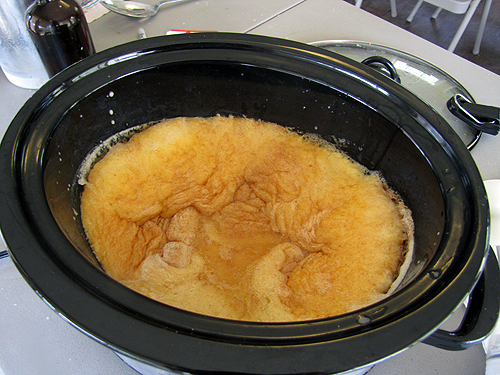
You can see it bubbling at the sides of the pot if you dip a spoon in there.
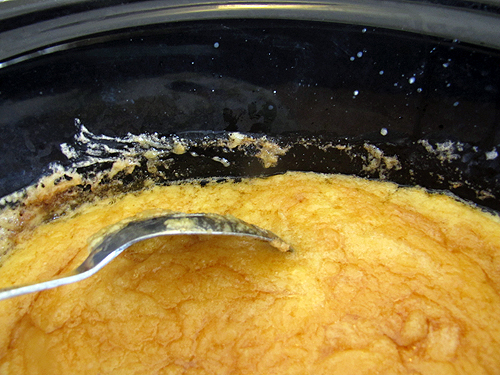
This is one of the tricky aspects of a milk soap. When using fresh farm milk, it’s impossible to account for the exact amount of cream content in the milk, especially goat’s milk which is homogenized and not readily skimmed. Basically, it’s extremely super-fatted. Put the stick blender back in the crock and re-emulsify it.

End of the cook:

The rapid re-emulsification with the stick blender will speed the finish time, and help keep the soap from over-cooking or darkening or getting a cooked-milk stink. I use a 1% phenolphthalein solution to test the soap.
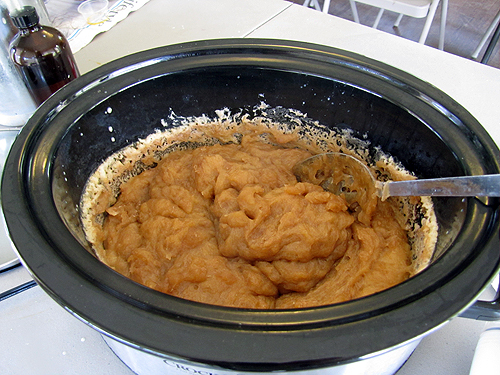
Done.
Step 6
Before placing hot process soap in the mold, I always transfer it first to a stainless steel bowl. This is where I mix in additives and fragrances. I like to get it off the heat as quickly as possible. If you’ve paid attention to your soap and not over-cooked it, it will still be in a smooth and workable state for another 5-10 minutes. Especially if I’m adding fragrances, I like to stir the soap around and cool it slightly before adding scents.

The soap in this state, just finished, looks dark, but when it cools and hardens, it will lighten. For this soap, I didn’t add any additives or fragrances at all. I wanted to show a baseline on how light the soap is in this method if you don’t add any fragrance or additives that could affect color.
Step 7
Place the soap in the prepared mold. I’m using a loaf mold here.
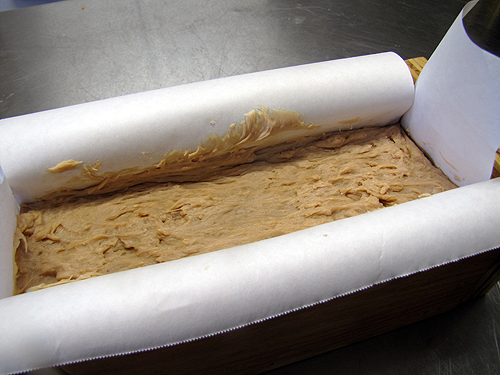
Put the soap in the freezer. This quick cool-down will further interact with the rest of the “cold process treatment” we’ve given this hot process soap to keep the color lighter by kicking back the heat on the soap as quickly as possible. Leave it in the freezer for at least two hours before removing. Let the soap come to room temperature before unmolding.
Here is the finished soap, unmolded.
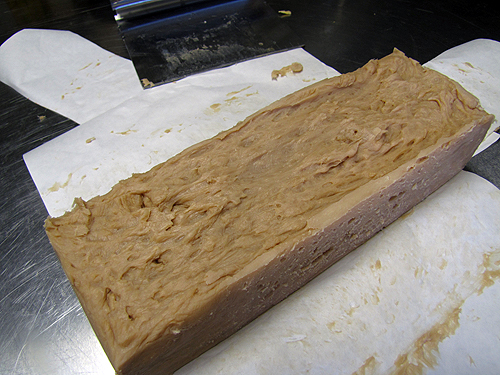
Here, cut into bars.

Here it is in comparison to another hot process goat’s milk soap, made without the “cold process treatment” method.

The difference is incredible. The keys to this method are: 1) Treating the soap with cold process techniques at the beginning by cooling the fats/oils and also cooling the lye/milk mixture not only by freezing the milk but by the very slow lye addition; 2) re-emulsifying with the stick blender at mid-cook to speed the cooking process and lessen the heat effects on the milk; and 3) freezing the finished soap in the mold to quickly kick back the heat. Hot process soap–but with a cold process treatment.
See how to make “regular” hot process soap here to see the differences in the methods.
As the soap sits and cures to harden, the color doesn’t change or darken.
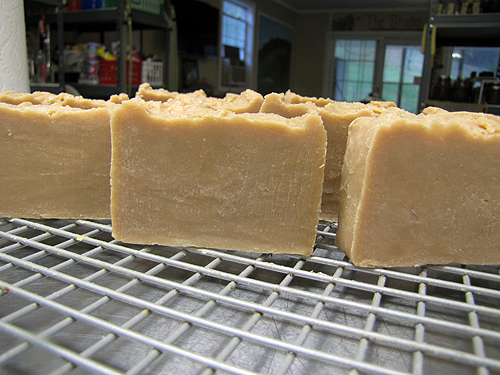
Now that’s perfect hot process goat’s milk soap! Light, mild, creamy, and 100% goat’s milk.
If you try my method, let me know how it works for you! Note: Your mileage will vary if you include additives or fragrances that darken soap.


Louise says:
I am going to have to try this. It looks great. Since I’m working all week it will have to wait until the weekend. Thank you Suzanne.
On March 28, 2016 at 10:16 am
Joell says:
:happyflower:
It seems this would be a nice face soap, I am one that can not use cleansers on my face, I like the feel of clean and then apply a light face cream. Will you be marketing this soap by chance?
On March 29, 2016 at 8:04 am
Suzanne McMinn says:
Joell, send me an email at [email protected]!
On March 29, 2016 at 8:28 am
outbackfarm says:
Suzanne, I just made 2 batches, and followed your directions, but used my recipe. Just stuck them in the freezer an hour ago. I can already see they are lighter. I’ll post pics on my blog later. Thanks so much!
On March 29, 2016 at 3:05 pm
Suzanne McMinn says:
I’m so glad it worked out well for you! Please come back and post the link to your post on your blog! And yes, I think this method would work with any recipe. It’s the method, not the recipe, that matters.
On March 29, 2016 at 6:49 pm
jodiezoeller says:
Are you going to be selling soap again? I’ll buy some in advance for Christmas presents this year and birthday presents and just because presents.
On April 22, 2016 at 4:02 pm
jr says:
Hi, just wondering if there’s a typo with the lye amount
I put the recipe through the lye calculator after a failed batch and it said less then half of what you have there.
On December 24, 2018 at 3:46 am